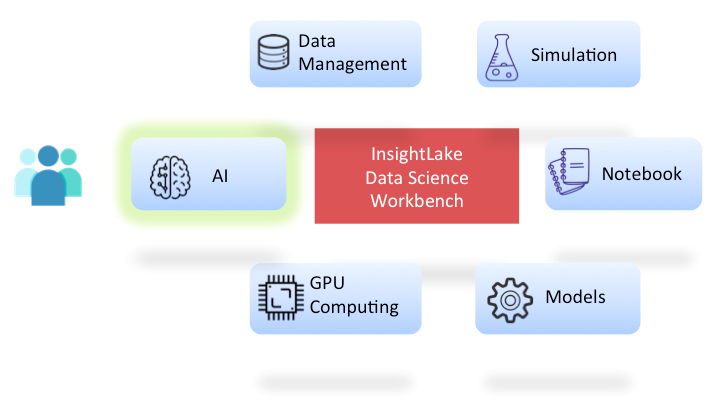


Data science is an exploratory work, where data scientists perform many steps while building models. Few of those steps are: Ingest data from different sources (Operational data, Market data, Macro economic data, Public data etc..) Perform statistical analysis of fields Clean and standardize data sets Build models (Python, R, Scala, Java...etc) Train & validate models Monitor models and perform calibration (Variance analysis) Work in groups, share drafts and published versions Once model is ready, obtain approvals from model & data governance teams Work with data/IT to perform promotion of models from DEV to QA to PROD Build and run multiple models/algorithms together (Main & experimental models) Run models on Big Data, GPU cluster (On Premise or Cloud) etc.
Data science workbench is a self service tool/solution, which enables data scientists to perform variety of data tasks choosing their choice of language (R, Python, Scala etc). It allows data scientists, analysts and business users to collaborate together. Few of the features of workbench are: Managing projects & data science/analyst teams Data ingestion, transformation and exploration Model & notebook building and visualization Compute resource allocation Monitoring, devops etc
As you see from model building steps, it is a long exploratory work. Just like a Pharma scientist, who will break down compound building in multiple steps, produce analysis, data scientists will also need to break down exploratory work in steps and produce evidence/analysis to prove hypothesis. We can call this data story building, which can tell us what do we need to do with data to get to the right model output. To create data stories data scientists rely on notebooks or BI visual tools. Few of the popular notebooks are: Jupyter H2O Zeppelin etc..
InsightLake data science workbench enables data scientists/analysts to use their choice of language to build complex ML/Simulation data pipelines using hundreds of algorithms. It provides following features to assist data scientists: Big Data - Integrated with Hadoop & Spark Data management - for importing, cleaning and standardizing data sets Data Explorer - for data analysis & visualization Notebook - Create data stories using any language Engines - Language based engines, H2O, TensorFlow ML/DL Algorithms - Hundreds of algorithms GPU Computing - OpenCL & CUDA based framework Security - Data security, Masking and Role based access/sharing


Workbench allows them to import/export their existing notebooks (InsightLake, Jupyter (Conda), H2O, Zeppelin). They can track the model performance over time and migrate models from DEV to QA to PROD very easily. Data science workbench also integrates with model governance framework allowing regulated industry (Financials, Insurance..) to validate, govern and monitor models.

InsightLake data science workbench provides flexibility and interoperability with other industry popular notebooks like Conda Jupyter, H2O and Zeppelin. Users can import these notebooks seamlessly and export new notebook in given format (with few restrictions).


InsightLake Data Science Workbench enables companies to use power of Hadoop so large amount of data can be used in training and validation instead of small sample set. This increases model precision and outcome.
Markdown - for HTML Python R Scala SQL H2O Java Script - Use InsightLake constructs seamlessly Many more....


Unsupervised - K-means... Supervised - Bayes, Random Forest... Regression - Logistic, MARS.. Dimensionality Reduction - PCA, LDA.. Recommendation/Association Rule Learning - Apriori Hidden Chains - HMM Ensemble - GBM.. AI - Perceptron, Hopfield... Deep Learning - Perceptron, CNN, RNN...
InsightLake Workbench enables data scientists to perform Monte Carlo simulation. Different types of probability distributions are supported for example:
Normal Triangular Uniform

InsightLake workbench allows data scientists to build and run models on GPU clusters. AWS AMIs could be used to setup a cluster very easily. With the power of GPUs complex multi layer/high compute deep learning models can be effectively run on GPU clusters. Two options are provided: CUDA - with Caffe & Tensorflow OpenCL - with Torch
InsightLake Workbench enables data scientists to perform Monte Carlo simulation. Different types of probability distributions are supported for example:
